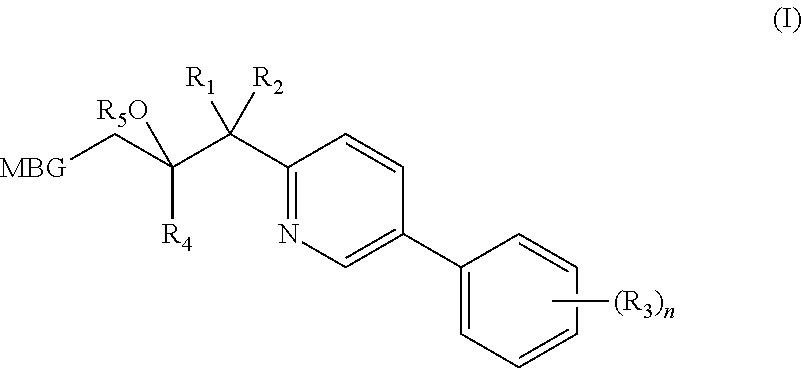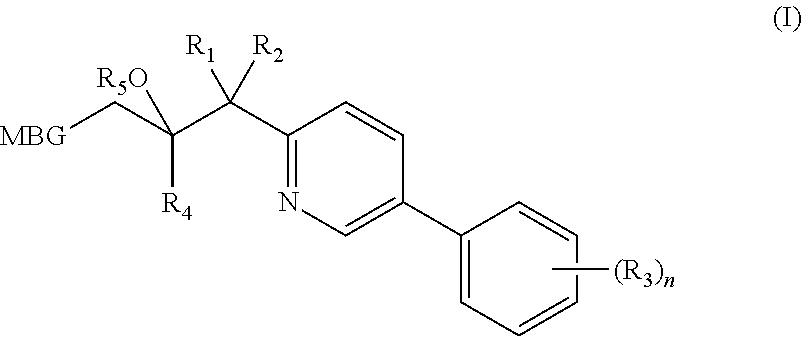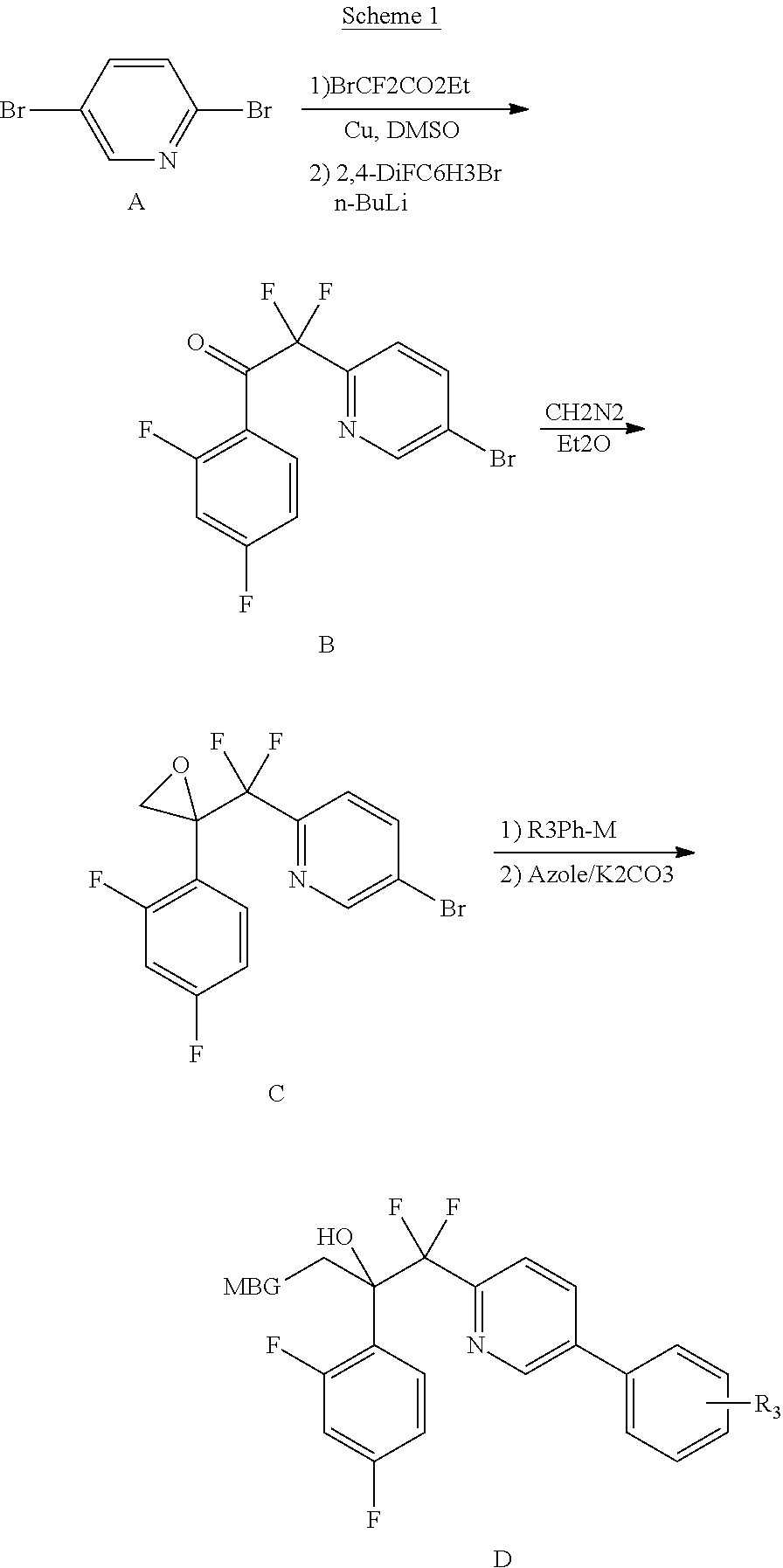Metalloenzyme inhibitor compounds
- Summary
- Abstract
- Description
- Claims
- Application Information
AI Technical Summary
Benefits of technology
Problems solved by technology
Method used
Image
Examples
example 1
[0206]
4-(6-(2-(2,4-Difluorophenyl)-1,1-difluoro-2-hydroxy-3-(1H-tetrazol-1-yl)propyl)pyridin-3-yl)benzonitrile (1)
[0207]To a stirred solution of epoxide C (0.3 g, 0.82 mmol) and 4-cyano-benzene boronic acid (0.14 g, 0.99 mmol) in 1,4-dioxane (5 mL) was added K2CO3 (0.17 g, 1.24 mmol) at RT under inert atmosphere. After purge with argon for a period of 30 min, Pd(dppf)2Cl2 (30 mg, 0.041 mmol) was added to the reaction mixture under argon atmosphere. The resulting mixture was stirred for 8 h at 75° C. Progress of the reaction was monitored by TLC. The solvent was evaporated under reduced pressure; the obtained residue was dissolved in water (20 mL). The aqueous layer was extracted with EtOAc (3×50 mL). The combined organic phases were washed with water, brine, dried over anhydrous Na2SO4 and concentrated. The crude material was purified by column chromatography to afford coupled product (0.15 g, 0.39 mmol, 47%) as a solid. 1H NMR (500 MHz, CDCl3): 8.87 (s, 1H), 7.95 (dd, J=8.0, 2.0 Hz...
example 2
[0209]
2-(2,4-Difluorophenyl)-1,1-difluoro-3-(1H-tetrazol-1-yl)-1-(5-(4-(trifluoromethyl)phenyl)pyridin-2-yl)propan-2-ol (2)
[0210]To a stirred solution of bromo-epoxide C (0.25 g, 0.69 mmol) in THF (20 mL) and water (7 mL) were added 4-(trifluoromethyl)phenylboronic acid (0.10 g, 0.55 mmol), Na2CO3 (0.16 g, 1.55 mmol) and Pd(dppf)2Cl2 (0.14 g, 0.17 mmol) at RT under inert atmosphere. After purged with argon for a period of 30 min, the reaction mixture was heated to 75° C. and stirring was continued for 4 h. Progress of the reaction was monitored by TLC. The reaction mixture was cooled to RT and filtered through a pad of celite. The filtrate was concentrated under reduced pressure; obtained residue was dissolved in EtOAc (30 mL). The organic layer was washed with water, brine and dried over anhydrous Na2SO4 and concentrated under reduced pressure. The crude compound was purified by column chromatography to afford coupled product (0.21 g, 0.49 mmol, 71%) as solid. 1H NMR (500 MHz, CDCl...
example 3
[0216]
3-(6-(2-(2,4-Difluorophenyl)-1,1-difluoro-2-hydroxy-3-(1H-tetrazol-1-yl)propyl)pyridin-3-yl)benzonitrile (3)
[0217]Compound 3 was prepared using the conditions employed for 1. 0.020 g as a tan solid. 1H NMR (500 MHz, CDCl3): 8.76 (s, 1H), 8.71 (s, 1H), 7.99 (dd, J=8.0, 2.0 Hz, 1H), 7.84 (s, 1H), 7.80-7.76 (m, 2H), 7.72 (d, J=8.0 Hz, 1H), 7.65 (t, J=7.5 Hz, 1H), 7.43-7.38 (m, 2H), 6.81-6.76 (m, 1H), 6.72-6.68 (m, 1H), 5.54 (d, J=14.5 Hz, 1H), 5.20 (d, J=14.5 Hz, 1H). HPLC: 93.95%. MS (ESI): m / z 455 [M++1].
PUM
| Property | Measurement | Unit |
|---|---|---|
| Molar density | aaaaa | aaaaa |
| Pharmaceutically acceptable | aaaaa | aaaaa |
Abstract
Description
Claims
Application Information
 Login to View More
Login to View More - R&D
- Intellectual Property
- Life Sciences
- Materials
- Tech Scout
- Unparalleled Data Quality
- Higher Quality Content
- 60% Fewer Hallucinations
Browse by: Latest US Patents, China's latest patents, Technical Efficacy Thesaurus, Application Domain, Technology Topic, Popular Technical Reports.
© 2025 PatSnap. All rights reserved.Legal|Privacy policy|Modern Slavery Act Transparency Statement|Sitemap|About US| Contact US: help@patsnap.com



